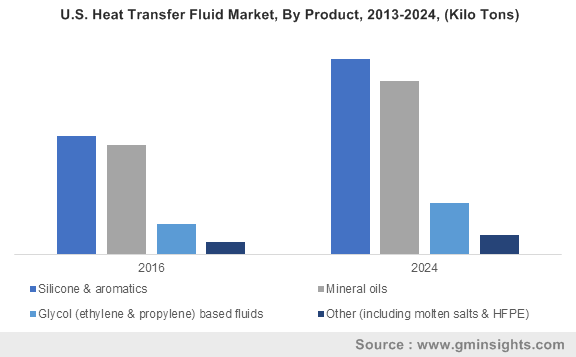Home > Chemicals & Materials > Advanced Materials > Heat Transfer Fluid Market
Heat Transfer Fluid Market Size
- Report ID: GMI415
- Published Date: Sep 2017
- Report Format: PDF
Heat Transfer Fluid Market Size
Heat Transfer Fluid Market size was worth over USD 2.2 billion in 2016 and will surpass 820 kilo tons by 2024

Rapid development in emerging economies, especially in automotive, metal processing, chemical and oil & gas sectors will drive heat transfer fluid market growth. The increasing necessity for maintaining temperature in these sectors will be a major factor responsible for heat transfer fluid demand. The excess of warmness and energy is utilized in major industrial sectors including, HVAC, chemical and concentrated solar power plants.
Rising demand for specific application based HTF for optimum energy efficiency is expected to propel industry growth. Further, elevated temperature control properties and cost saving operation compared to its counterparts including, steam and electric will support product penetration.
Implementation of CSP facilities in industrialized countries to promote renewable energies will also propel heat transfer fluid market size. Favourable thermal properties along with high temperature holding capabilities of the product has enhanced the industry demand. Solar energy is the most cost-efficient source of power generation along with reduced levels of carbon emissions. Enhanced longevity, high thermal storage and concentrated power are the key factors enhancing the CSPs over conventional PV solar panels.
| Report Attribute | Details |
|---|---|
| Base Year: | 2016 |
| Heat Transfer Fluid Market Size in 2016: | 2.2 Billion (USD) |
| Forecast Period: | 2017 to 2024 |
| Forecast Period 2017 to 2024 CAGR: | 6.5% |
| 2024 Value Projection: | 4.2 Billion (USD) |
| Historical Data for: | 2013 to 2016 |
| No. of Pages: | 220 |
| Tables, Charts & Figures: | 151 |
| Segments covered: | Product, Application, and Region |
Increasing natural gas production particularly in Gulf Cooperation Council (GCC) will drive industry growth. Growth in natural gas production will lead to increase in demand for synthetic lubricants including HTFs. Oil refineries use the product for warming and distillation of oil and oil-based products.
Shifting preference from traditional water or steam systems towards the thermal liquid systems in several industries will drive the business growth of heat transfer fluid market. Replacement of traditional steam systems with heat transfer fluid system is expected to drive the product demand. High temperature control, environmental safety, production efficiency and low maintenance are the key driving properties of heat transfer fluid market.
Factors including, stringent environment regulations and unstable raw material supply owing to fluctuating crude oil & base oil production will impact heat transfer fluid market price trend. However, increasing penetration of bio based and biodegradable product is expected to create new avenues for industry participants.
